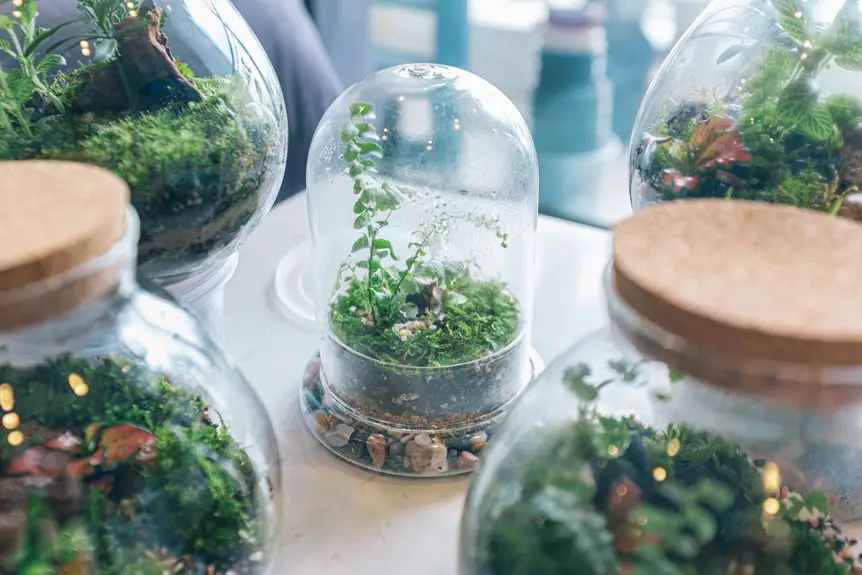Yes, plants can definitely help regulate humidity in a dry office environment! They release moisture into the air through a process called transpiration, which can greatly enhance comfort and productivity. Incorporating humidity-boosting plants like spider plants or peace lilies not only improves air quality but also creates a calming atmosphere. This helps in reducing stress levels and encourages teamwork. Discovering the best plants and care tips can further enhance these benefits for your workspace.
Table of Contents
Key Takeaways
- Plants release moisture into the air through transpiration, increasing humidity levels in dry office environments.
- Increased humidity from plants can enhance comfort, improve air quality, and boost employee productivity.
- Incorporating humidity-boosting plants like spider plants and peace lilies can effectively raise moisture levels indoors.
- Healthy plants contribute to a calming atmosphere, reducing stress and promoting overall well-being in the workspace.
- Regular care and monitoring of humidity levels ensure optimal plant health and maximize their humidity-regulating benefits.
The Science Behind Humidity Regulation
When you consider the role of humidity in your office, it’s essential to understand how plants can help regulate it.
Humidity refers to the amount of moisture in the air, impacting comfort and productivity. When humidity levels are too low, it can lead to dry skin, respiratory issues, and decreased concentration.
Humidity levels significantly affect comfort and productivity, with low humidity causing dry skin and decreased concentration.
Plants, through their biological processes, play a vital role in maintaining ideal humidity levels. They absorb water through their roots and release moisture into the air via transpiration. This natural process can increase humidity, creating a more pleasant environment.
Additionally, certain plants are particularly effective at enhancing humidity, making them valuable additions to your workspace. By incorporating these plants, you can improve air quality and overall well-being in your office.
How Plants Release Moisture Into the Air
Plants play an essential role in increasing humidity through a process called transpiration. As you care for them, they release moisture into the air, which can help create a more comfortable environment.
Let’s explore how this process works and which plants are best for boosting humidity in your office.
Transpiration Process Explained
Transpiration is a fascinating process where moisture escapes from the leaves of plants into the air.
As you observe a plant, you might notice tiny openings called stomata on the leaves’ surface. These stomata regulate gas exchange and allow water vapor to exit.
When sunlight hits the leaves, it warms them, and this heat causes water within the plant to evaporate. The moisture then travels through the stomata into the surrounding air.
This process not only cools the plant but also increases humidity in your environment.
Types of Humidity-Boosting Plants
While many plants can enhance humidity levels in your office, some are particularly effective at releasing moisture into the air.
Spider plants, for instance, are low-maintenance and thrive in various light conditions, making them a great choice.
Peace lilies not only add beauty but also release significant humidity while improving air quality.
Boston ferns are excellent at increasing moisture levels, but they prefer a bit more attention and humidity themselves.
Rubber plants are another option, known for their glossy leaves and ability to retain moisture.
Finally, the popular pothos is easy to care for and can help maintain a comfortable humidity balance.
Top Plants for Humidity Control in Offices
When it comes to enhancing the humidity levels in your office, certain plants can make a significant difference.
These green companions not only beautify your workspace but also help create a more comfortable environment.
Here are some top plants you should consider:
- Spider Plant: Easy to care for and excellent at increasing humidity.
- Peace Lily: Known for its stunning white blooms and air-purifying qualities.
- Boston Fern: A lush option that thrives in moist conditions, perfect for humidity.
- Rubber Plant: Its large leaves are great for absorbing moisture and purifying the air.
- Areca Palm: This elegant plant adds a tropical feel while effectively raising humidity levels.
Adding these plants to your office can transform your work atmosphere into a revitalizing oasis.
Benefits of Improved Humidity Levels
Improved humidity levels in your office can lead to a range of benefits that enhance both comfort and productivity.
When the air isn’t too dry, you’ll notice fewer respiratory issues, which means less coughing and sneezing. This can create a healthier environment for you and your colleagues.
Proper humidity also helps to reduce static electricity, minimizing disruptions with electronic devices. You might find it easier to focus and feel more energized as your skin feels less itchy and your eyes less dry.
Additionally, maintaining ideal humidity can protect your office equipment and furniture from damage, ensuring a longer lifespan.
Ultimately, cultivating a balanced humidity level can boost overall morale and enhance the workplace atmosphere.
The Role of Photosynthesis in Humidity Regulation
Photosynthesis plays an essential role in regulating humidity in your office.
As plants absorb light and carbon dioxide, they release water vapor through a process called transpiration.
This natural release of moisture can greatly impact your indoor climate, creating a more comfortable environment.
Photosynthesis and Water Vapor
While you mightn’t think of plants as key players in office humidity, their role in photosynthesis greatly impacts the moisture levels in indoor environments.
During photosynthesis, plants absorb carbon dioxide and release oxygen, but they also produce water vapor as a byproduct. This process can help maintain a balanced humidity level, making your workspace feel fresher and more comfortable.
Consider the benefits of plants in your office:
- They create a calming atmosphere.
- They boost your mood and productivity.
- They help reduce stress levels.
- They promote better air quality.
- They foster a connection to nature.
Incorporating plants into your workspace not only supports humidity regulation but also enhances your overall well-being.
Transpiration Process Explained
As plants engage in the transpiration process, they release water vapor into the air, greatly influencing humidity levels in your office. This process occurs when water absorbed by roots travels through the plant and evaporates from tiny pores in the leaves called stomata.
You mightn’t notice it, but this subtle release of moisture can considerably raise indoor humidity. Transpiration is also a byproduct of photosynthesis, where plants convert sunlight into energy, using carbon dioxide and water.
The more actively your plants photosynthesize, the more water vapor they emit. Thus, maintaining a few healthy plants in your workspace not only beautifies the environment but also creates a more comfortable humidity level, enhancing your overall well-being.
Impact on Indoor Climate
The process of photosynthesis plays an essential role in regulating indoor humidity, especially in office environments.
As plants convert carbon dioxide into oxygen, they also release moisture into the air through transpiration. This natural process not only enhances humidity levels but also creates a more comfortable atmosphere for you and your colleagues.
Consider the benefits of having plants in your workspace:
- Fresh air that invigorates your mind.
- Reduced stress, leading to better focus.
- Enhanced creativity, sparking innovative ideas.
- Improved well-being, promoting overall health.
- Aesthetic beauty, transforming dull spaces into vibrant ones.
Combining Plants With Other Humidity Solutions
Integrating plants into your office environment can greatly enhance humidity levels, but combining them with other humidity solutions can yield even better results.
Consider using a humidifier alongside your plants to maintain consistent moisture in the air. This can be especially useful during winter months when indoor heating tends to dry out the atmosphere.
You might also want to group plants together; they can create a microclimate that increases humidity through their natural transpiration process.
Additionally, placing bowls of water near your plants can help boost humidity. This combination not only improves the overall air quality but also fosters a more vibrant workspace.
Tips for Caring for Office Plants
Combining plants with humidity solutions can greatly boost their health and your office’s atmosphere, but caring for those plants is just as important.
Integrating plants with humidity solutions enhances both their vitality and your office environment, making proper care essential.
To keep your office greenery thriving, follow these tips:
- Water wisely: Check soil moisture before watering; overwatering can harm roots.
- Choose the right spot: Place plants in bright, indirect light for ideal growth.
- Dust those leaves: Wipe leaves with a damp cloth to enhance photosynthesis.
- Fertilize occasionally: Use a balanced fertilizer during the growing season for extra nutrients.
- Watch for pests: Keep an eye out for insects; early detection can save your plants.
Designing a Plant-Friendly Workspace
Creating a plant-friendly workspace not only enhances your office’s aesthetics but also improves air quality and boosts productivity.
Start by selecting low-maintenance plants that thrive in indoor environments, like snake plants or pothos. Place them strategically near windows for natural light while ensuring they don’t obstruct pathways. Use decorative pots to match your office decor, adding a personal touch.
Consider creating a dedicated plant corner or hanging planters to maximize space. Regularly check for proper watering and humidity levels, adjusting as needed. Encourage team members to care for the plants together, fostering a collaborative atmosphere.
Finally, incorporate a variety of plant sizes and types to create visual interest and a revitalizing ambiance that can invigorate your workspace.
Real-Life Examples of Plants Enhancing Office Environments
When you think about transforming office spaces, real-life examples of plants making a difference can be quite inspiring.
Many companies have successfully integrated greenery into their work environments, leading to happier and healthier employees. For instance, a tech firm introduced snake plants, which not only improved air quality but also boosted productivity. A marketing agency decorated with pothos saw a significant drop in stress levels among its team.
Here are some heartwarming examples of plants enhancing office environments:
- Employees report increased creativity and collaboration.
- Workplaces feel more inviting and less sterile.
- Team members take pride in caring for their plants.
- Natural elements help reduce burnout and fatigue.
- Offices become a haven of tranquility amidst the hustle.
Frequently Asked Questions
How Many Plants Are Needed to Effectively Regulate Office Humidity?
Imagine a lush oasis in your office. To effectively regulate humidity, you’ll need at least 2-3 medium-sized plants for every 100 square feet. Their leaves drink in the air, creating a revitalizing atmosphere.
Can Artificial Plants Help With Humidity Levels?
Artificial plants can’t regulate humidity like real ones can. They don’t absorb or release moisture, so you won’t experience any benefits in humidity levels. For effective humidity control, you’ll want to invest in real plants.
Do Certain Plants Work Better in Specific Climates?
You might be surprised to learn that certain plants thrive in specific climates. Choosing the right species can enhance your environment, providing the perfect balance of moisture and temperature while improving air quality and aesthetics.
What Are the Signs of Overwatering Office Plants?
If you’re overwatering your office plants, look for yellowing leaves, wilting stems, or mushy roots. You might also notice a foul smell from the soil, indicating root rot. Adjust your watering routine accordingly.
Can Humidity Levels Affect Employee Productivity and Health?
Yes, humidity levels can greatly impact your productivity and health. When humidity’s too low, you might experience dry skin or respiratory issues, leading to discomfort that distracts you from your work and decreases overall performance.




